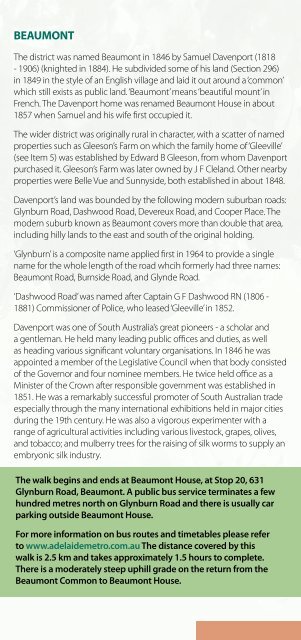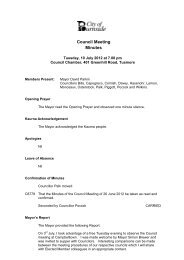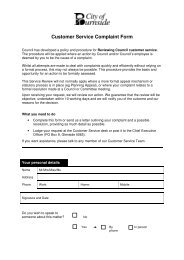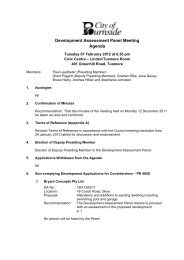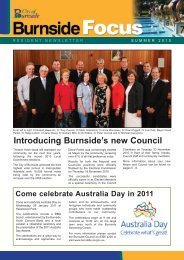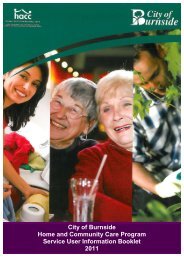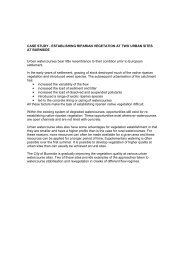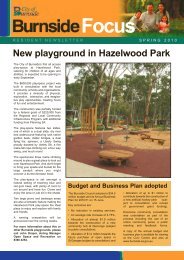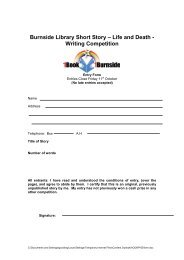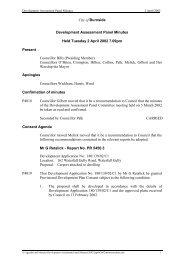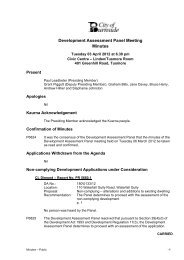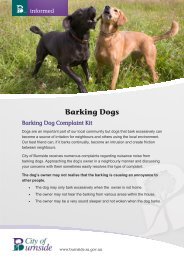Historic Self-Guided Walk Beaumont - Meetup
Historic Self-Guided Walk Beaumont - Meetup
Historic Self-Guided Walk Beaumont - Meetup
- No tags were found...
You also want an ePaper? Increase the reach of your titles
YUMPU automatically turns print PDFs into web optimized ePapers that Google loves.
BEAUMONTThe district was named <strong>Beaumont</strong> in 1846 by Samuel Davenport (1818- 1906) (knighted in 1884). He subdivided some of his land (Section 296)in 1849 in the style of an English village and laid it out around a ‘common’which still exists as public land. ‘<strong>Beaumont</strong>’ means ‘beautiful mount’ inFrench. The Davenport home was renamed <strong>Beaumont</strong> House in about1857 when Samuel and his wife first occupied it.The wider district was originally rural in character, with a scatter of namedproperties such as Gleeson’s Farm on which the family home of ‘Gleeville’(see Item 5) was established by Edward B Gleeson, from whom Davenportpurchased it. Gleeson’s Farm was later owned by J F Cleland. Other nearbyproperties were Belle Vue and Sunnyside, both established in about 1848.Davenport’s land was bounded by the following modern suburban roads:Glynburn Road, Dashwood Road, Devereux Road, and Cooper Place. Themodern suburb known as <strong>Beaumont</strong> covers more than double that area,including hilly lands to the east and south of the original holding.‘Glynburn’ is a composite name applied first in 1964 to provide a singlename for the whole length of the road whcih formerly had three names:<strong>Beaumont</strong> Road, Burnside Road, and Glynde Road.‘Dashwood Road’ was named after Captain G F Dashwood RN (1806 -1881) Commissioner of Police, who leased ‘Gleeville’ in 1852.Davenport was one of South Australia’s great pioneers - a scholar anda gentleman. He held many leading public offices and duties, as wellas heading various significant voluntary organisations. In 1846 he wasappointed a member of the Legislative Council when that body consistedof the Governor and four nominee members. He twice held office as aMinister of the Crown after responsible government was established in1851. He was a remarkably successful promoter of South Australian tradeespecially through the many international exhibitions held in major citiesduring the 19th century. He was also a vigorous experimenter with arange of agricultural activities including various livestock, grapes, olives,and tobacco; and mulberry trees for the raising of silk worms to supply anembryonic silk industry.The walk begins and ends at <strong>Beaumont</strong> House, at Stop 20, 631Glynburn Road, <strong>Beaumont</strong>. A public bus service terminates a fewhundred metres north on Glynburn Road and there is usually carparking outside <strong>Beaumont</strong> House.For more information on bus routes and timetables please referto www.adelaidemetro.com.au The distance covered by thiswalk is 2.5 km and takes approximately 1.5 hours to complete.There is a moderately steep uphill grade on the return from the<strong>Beaumont</strong> Common to <strong>Beaumont</strong> House.


